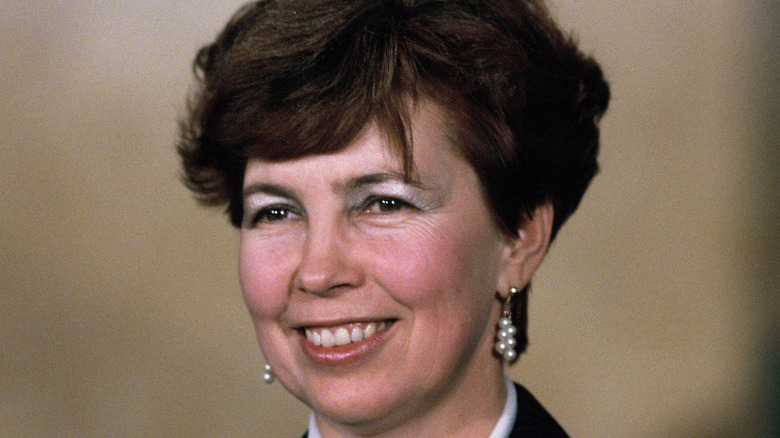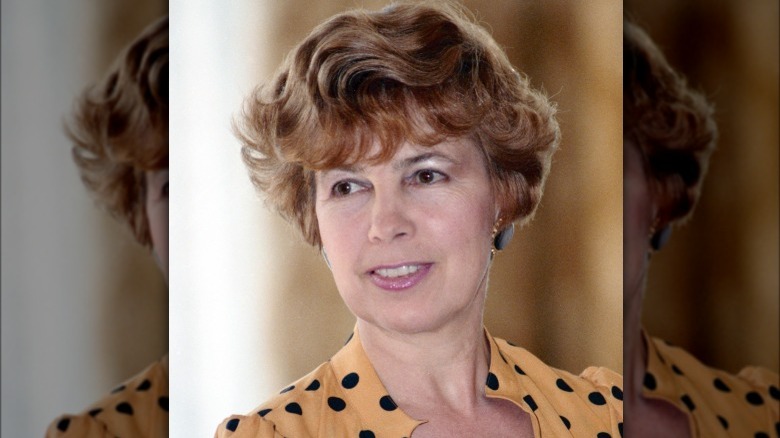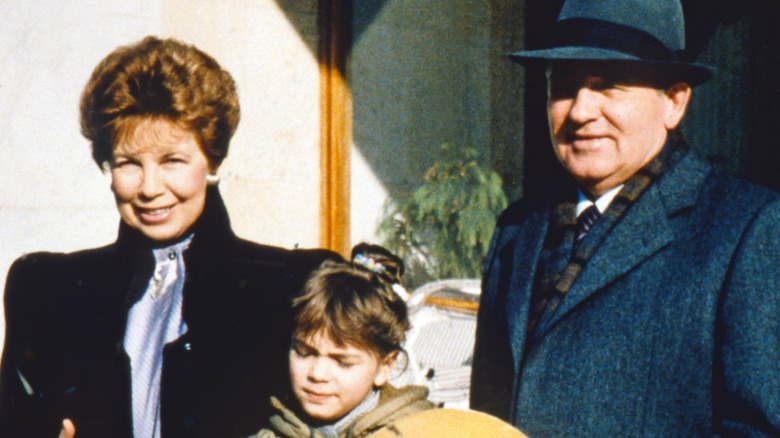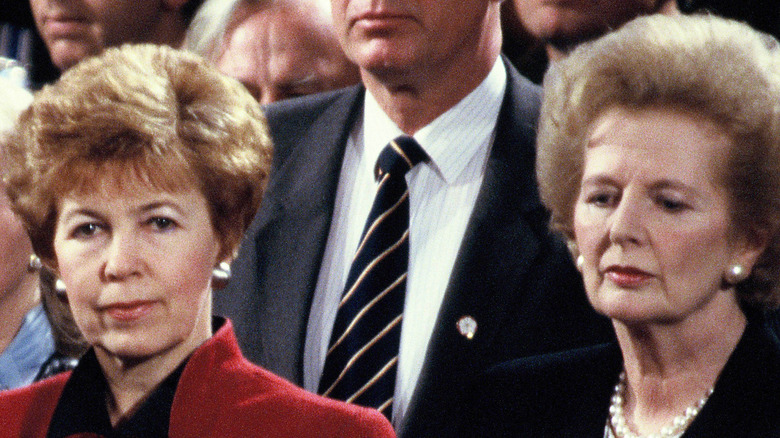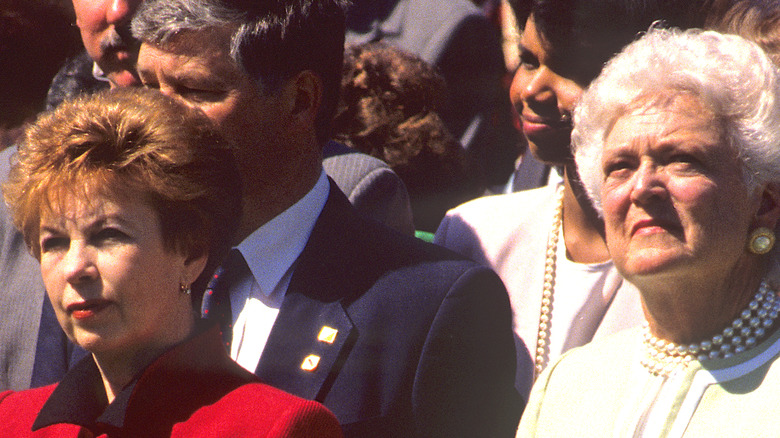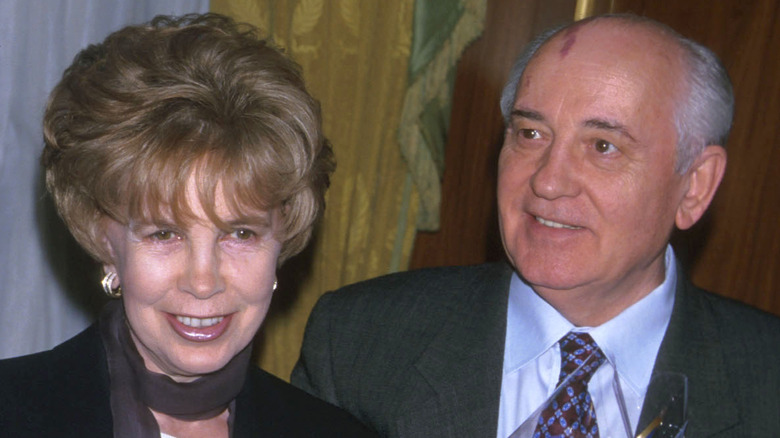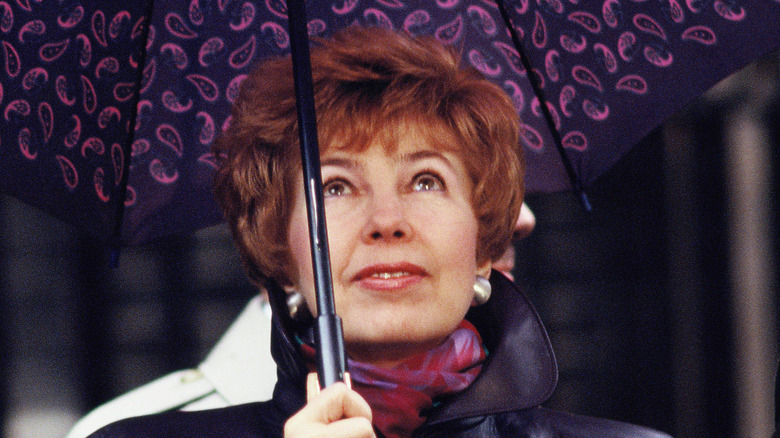The 1999 Death Of Mikhail Gorbachev's Wife, Raisa, Explained
Raisa Gorbachev was a high-profile first lady of the Soviet Union, known for her glamorous outfits and sponsorship of charitable causes (via BBC). She dedicated her life to politics along with her husband, former Soviet leader Mikhail Gorbachev, and to her own causes, helping those in need. So how did Raisa Gorbachev die — and what happened in the aftermath of her death?
Per The Washington Post, she was born Raisa Maksimova Titorenky on January 5, 1932, in Rubtsovsk, Siberia, and raised in a small village. Her father worked as a railroad engineer, and the family would travel throughout the Soviet Union during Gorbachev's childhood. Time Note reports that she and her three siblings spent lots of time exploring the Ural Mountain regions.
According to The Gorbachev Foundation, she did well in school, despite the constant traveling. She graduated secondary school with a gold medal, and decided to study philosophy at Moscow State University.
From peasant to teacher
Her time at university proved fateful: She met her future husband, Mikhail Gorbachev (above) (per The Gorbachev Foundation). He was studying law. The Washington Post reports that the couple married in 1954. Mikhail also came from a family of peasants, and they were so poor when they married that Raisa had to borrow a pair of white shoes for the ceremony. The Gorbachev Foundation reports that the Gorbachevs had their daughter, Irina, in 1954.
Raisa Gorbachev graduated from the Lenin Pedagogical Institute with a doctorate in sociology. According to The Washington Post, she drew on her upbringing when she wrote her thesis about the characteristics of everyday life of farm peasantry. Gorbachev accepted a teaching position at the Stavropol Agricultural Institute.
The Washington Post reports that in 1985, Mikhail Gorbachev served the Soviet Union, first as a general secretary, and later as the President. As her husband rose in power, Raisa gave up her teaching job. She took an unpaid role on his staff starting in 1985.
High profile political spouse
Raisa enjoyed the political work with her husband. In one interview, she said, "I am very lucky with Mikhail. We are really friends, or if you prefer, we have great complicity."
The Famous People reports that in 1987, Raisa Gorbachev was named "Woman of the Year" by the British publication "Women's Own." Time Note says that it was a bit unusual for a first lady to have such a high profile, but Raisa redefined expectations for political spouses throughout her life.
BBC reports that Raisa additionally had a say in her husband's political decisions. At this time, women were expected to be seen, and not heard, which was a tradition that Raisa was happy to break (via The Washington Post). She caused an uproar when she told Mikhail to pay attention to a child one day while they were meeting with ordinary citizens. People were scandalized that a woman would make demands of her husband while they were in the public eye.
Ambitious charity work
Mikhail Gorbachev admired his wife's ambitions, which he detailed in a memoir (via The Washington Post). He wrote, "She visited the families of workers and the homes of peasants. She went to new and old neighborhoods and got to know how medical institutions, household services, shops operated, how the municipal and rural markets worked. This was due both to her natural curiosity and to her professional interest as a sociologist."
In 1989, Raisa (pictured above, left, with Great Britain's Margaret Thatcher) donated $100,000 to the International Association of Hematologists of the World for Children (via The Famous People). The charity raises money for vital equipment for Russian blood banks, and also funds training for Russian leukemia specialists to serve internationally. According to Time Note, her work had an impact that outlived Gorbachev: By 2000, children's leukemia survival rates had improved in Russia.
Her legacy included visiting with victims of the Chernobyl nuclear power plant tragedy, ensuring they got the help they needed (via The Washington Post). She was an international leader in the Soviet Cultural Foundation, and was a sponsor of a pediatric hospital.
Bold fashion and awkward encounters
Despite her charitable work, Raisa was frequently criticized because of her clothing choices, according to the Los Angeles Times. In 1989, she made international headlines after wearing a bright red outfit to meet the pope at the Vatican, which was unheard of in those days, when most Vatican visitors dressed in dark colors. She also clashed with former first lady Nancy Reagan on at least three awkward occasions. Reagan wrote, "My fundamental impression of Raisa Gorbachev was that she never stopped talking. Or lecturing, to be more accurate." But in 1990, Gorbachev met with former first lady Barbara Bush (above, right), which went much more smoothly (via Time Note). The two first ladies gave a commencement speech at Wellesley College, dedicating their speeches to the role that a modern woman plays in society.
Back at home her native Russia in 1991, the Soviet Union was beginning to break down (via Britannica). BBC reports that during the Soviet Union coup attempt in 1991, she and Mikhail were imprisoned. She struggled to recover from the toll that her imprisonment took on her and her family. Gorbachev stepped down from his government role that year (via Britannica). The same year, according to The Famous People, Raisa Gorbachev was awarded the "Women for Peace" award and the "Lady of the Year" award. In September 1991, she released a book titled "I Hope: Reminiscences and Reflections."
Lasting health problems
But then, in 1993, Gorbachev began to face several health problems (via The New York Times). First, she broke her arm after slipping and falling in the snow. She then had a stroke. According to the BBC, her stroke was caused by lasting damage after her imprisonment during 1991.
In 1997, per Time Note, Gorbachev founded the Raisa Maksimovna Club, which aimed to get more women involved with politics. But her health issues caught up with her once again. By 1999, Gorbachev was diagnosed with a rare form of blood cancer (via the Los Angeles Times). In July 1999, she underwent chemotherapy treatments, and was preparing to get a bone-marrow treatment, but grew too sick to receive the treatment.
Mikhail Gorbachev remained at Raisa's bedside through her final days. They were still devoted to each other to the end after spending 45 years together. Mikhail Gorbachev described Raisa, writing, "We were bound first of all by our marriage but also by our common view on life. We shared our common cares and helped each other always and in everything."
'An inspiration to people everywhere'
Throughout her life, though, Gorbachev was frequently criticized by her fellow countrymen for not only her demeanor, but also her clothes (per The Washington Post). After growing up poor, she transitioned to wearing fancy and expensive outfits that others in her country could never attain, attracting criticism. Yet people also expressed their sadness over her illness and their appreciation for and support of her as she lay in the hospital in 1999, sick with cancer. She took note of the positive messages: "I had to get sick with such a fatal illness and die to make people understand me" (via The Famous People).
As The Washington Post reports, when she was 67 years old, she spent her final days at the University Hospital in Muenster, Germany. Raisa Gorbachev died on September 20, 1999, of leukemia. She was buried in Novodevichy Cemetery in Moscow (via The Famous People).
Per The Washington Post, then-President Bill Clinton issued a statement following her death, saying, "The example she set, through her help for child victims of leukemia and through her own courageous struggle against this terrible disease, was an inspiration to people everywhere." Following her death, Gorbachev's family sought to keep her memory alive. They established the Raisa Gorbacheva Foundation, which has the stated goal of stopping childhood cancer (via Time Note).
